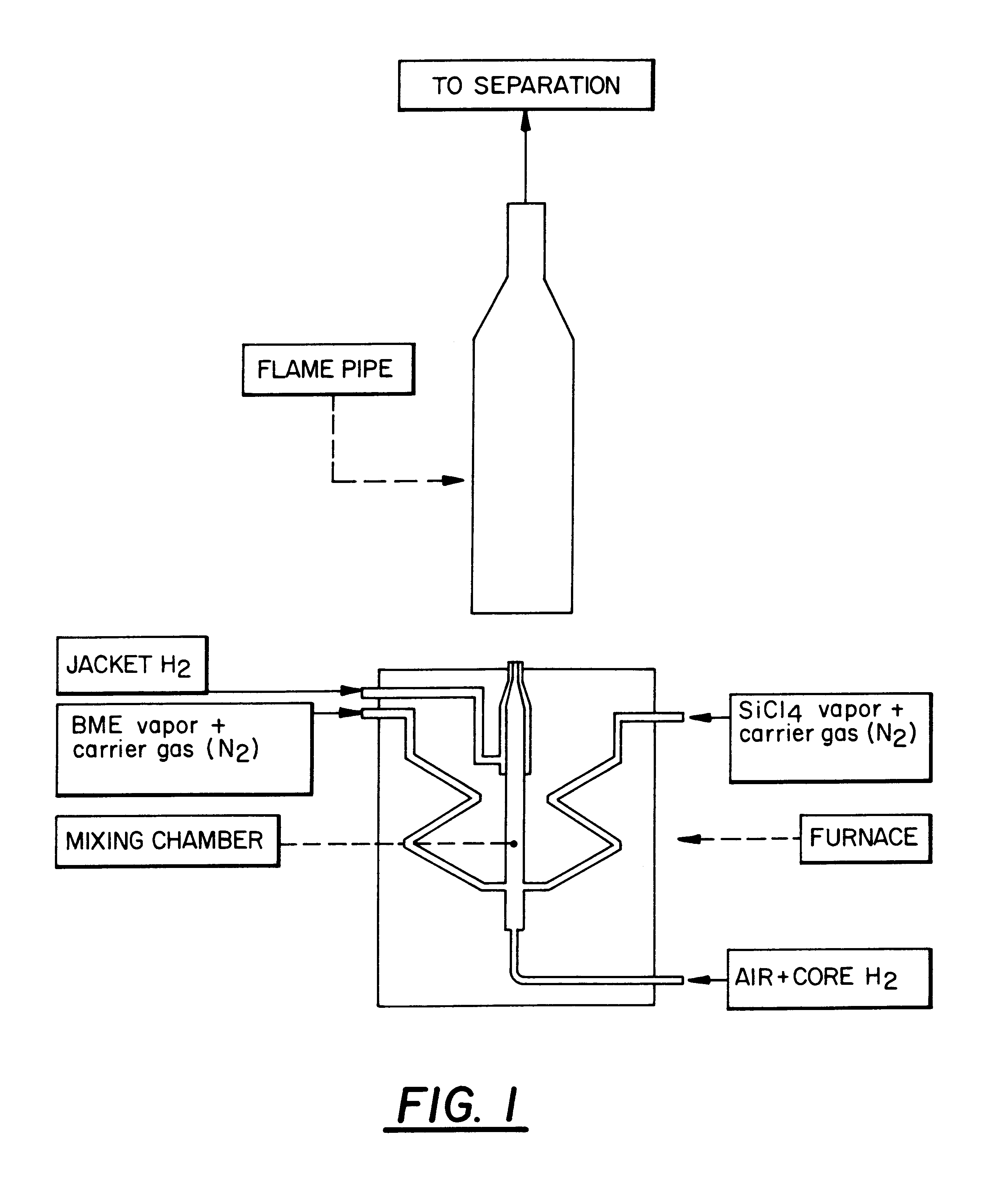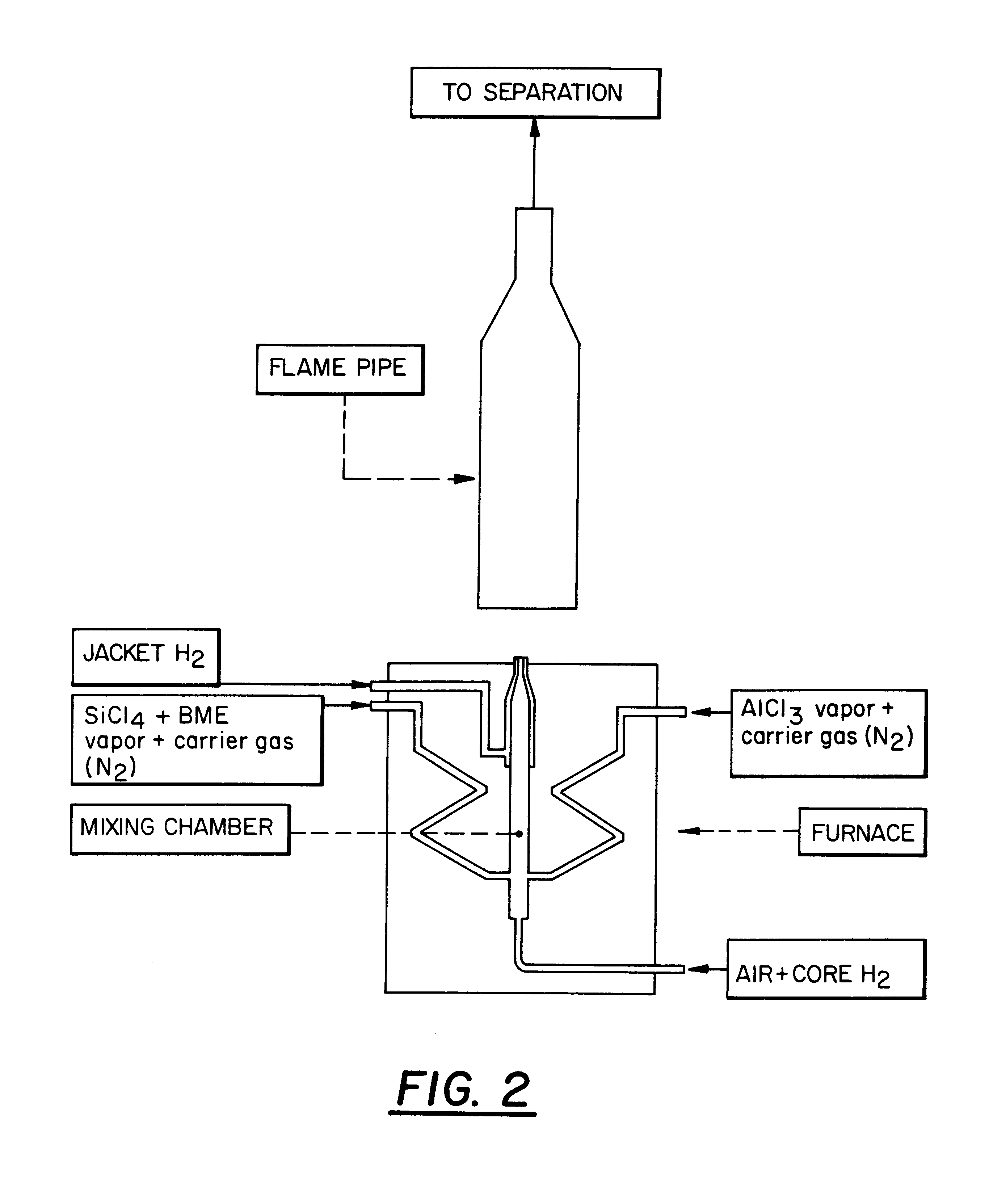Boron oxide-silicon dioxide mixed oxide
a technology of boron oxide and mixed oxide, which is applied in the direction of silicon oxide, silicon compounds, chemistry apparatus and processes, etc., can solve the problems of trichloride being used, boron oxide-silicon dioxide mixed oxide, and unsuitable for glass-making raw materials
- Summary
- Abstract
- Description
- Claims
- Application Information
AI Technical Summary
Benefits of technology
Problems solved by technology
Method used
Image
Examples
examples 1 to 4
The burner arrangement for examples 1 to 4 is shown diagrammatically in FIG. 1.
The burner is housed in a heated flirnace part, the temperature of the furnace being roughly the same as the outflow temperature of the gas mixture. The burner consists of a mixing chamber to which is connected a nozzle from which the gas mixture flows, as well as a second (jacket) nozzle annularly surrounding the first nozzle, from which in addition jacket) hydrogen is blown into the flame in order to avoid agglomerations (in the nozzle region).
example 1
1.0796 kg / h of SiCl4 are vaporised at ca. 130.degree. C. and conveyed together with 0.1 Nm.sup.3 / h of nitrogen as carrier gas into the mixing chamber of the burner. 0.51 Nm.sup.3 / h of air as well as 0.107 Nm.sup.3 / h of oxygen and 0.3 Nm.sup.3 / h of (core) hydrogen are) fed into the same mixing chamber.
0.0643 kg / h of trimethyl borate are vaporised at ca. 120.degree. C. in a separate vaporisation device and are likewise fed into the mixing chamber of the burner by entrainment in a stream of nitrogen (0.02 Nm.sup.3 / h). The gas mixture flows at a rate of 12 m / sec (referred to standard conditions) from the nozzle opening of the burner and bums in a reaction chamber (flame pipe).
The temperature of the gas mixture (SiCl.sub.4)-air-hydrogen, oxygen, trimethyl borate) is measured at the mouth of the burner, and is found to be 128.degree. C. 0.05 Nm.sup.3 / h of hydrogen (jacket hydrogen, room temperature) are fed into the annular nozzle surrounding the mouth of the burner.
After the flame ...
example 2
The procedure described in Example 1 is employed and the following amounts are used:
0.9387 kg / h of SiCl.sub.4 with 0.1 Nm.sup.3 / h of nitrogen as carrier gas, air 0.76 Nm.sup.3 / h, oxygen 0.159 Nm.sup.3 / h (core) hydrogen 0.268 Nm.sup.3 / h.
0.05 Nm.sup.3 / h of hydrogen are fed into the annular nozzle surrounding the mouth of the burner. The gas mixture flows at a rate of 14 m / sec (referred to standard conditions) from the nozzle opening of the burner.
0.1777 kg / h of trimethyl borate are vaporized in a separate vaporization device and likewise fed into the mixing chamber of the burner by entrainment in a stream of nitrogen (0.02 Nm.sup.3 / h).
The specific surface of the boron oxide-silicon dioxide mixed oxide is 34 m.sup.2 / g, and the analytically determined B.sub.2 O.sub.3 content is 13.3 wt. % (=4.1 wt. % of boron, calculated as boron).
The adjustment parameters are summarised again in Table 1.
The boron oxide-silicon dioxide obtained has the following particle size distribution:
Total n...
PUM
| Property | Measurement | Unit |
|---|---|---|
| temperatures | aaaaa | aaaaa |
| temperature | aaaaa | aaaaa |
| boiling point | aaaaa | aaaaa |
Abstract
Description
Claims
Application Information
 Login to View More
Login to View More - R&D
- Intellectual Property
- Life Sciences
- Materials
- Tech Scout
- Unparalleled Data Quality
- Higher Quality Content
- 60% Fewer Hallucinations
Browse by: Latest US Patents, China's latest patents, Technical Efficacy Thesaurus, Application Domain, Technology Topic, Popular Technical Reports.
© 2025 PatSnap. All rights reserved.Legal|Privacy policy|Modern Slavery Act Transparency Statement|Sitemap|About US| Contact US: help@patsnap.com



